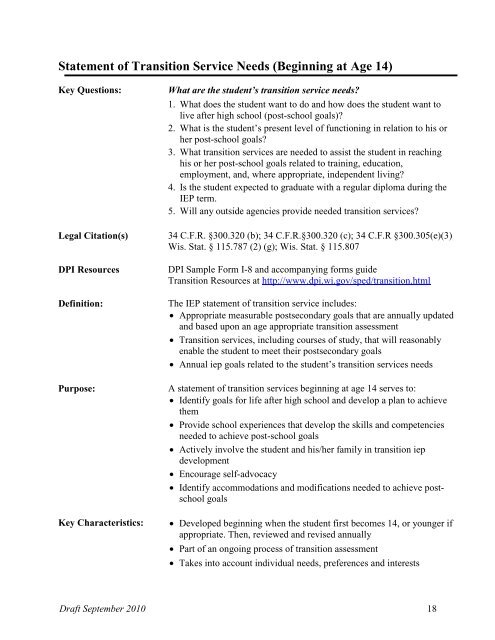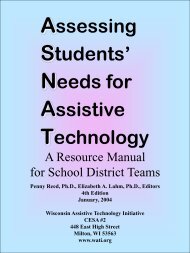Guide for Writing IEPs - The Special Education Team - Wisconsin.gov
Guide for Writing IEPs - The Special Education Team - Wisconsin.gov
Guide for Writing IEPs - The Special Education Team - Wisconsin.gov
You also want an ePaper? Increase the reach of your titles
YUMPU automatically turns print PDFs into web optimized ePapers that Google loves.
Statement of Transition Service Needs (Beginning at Age 14)<br />
Key Questions: What are the student’s transition service needs?<br />
1. What does the student want to do and how does the student want to<br />
live after high school (post-school goals)?<br />
2. What is the student’s present level of functioning in relation to his or<br />
her post-school goals?<br />
3. What transition services are needed to assist the student in reaching<br />
his or her post-school goals related to training, education,<br />
employment, and, where appropriate, independent living?<br />
4. Is the student expected to graduate with a regular diploma during the<br />
IEP term.<br />
5. Will any outside agencies provide needed transition services?<br />
Legal Citation(s) 34 C.F.R. §300.320 (b); 34 C.F.R.§300.320 (c); 34 C.F.R §300.305(e)(3)<br />
Wis. Stat. § 115.787 (2) (g); Wis. Stat. § 115.807<br />
DPI Resources DPI Sample Form I-8 and accompanying <strong>for</strong>ms guide<br />
Transition Resources at http://www.dpi.wi.<strong>gov</strong>/sped/transition.html<br />
Definition: <strong>The</strong> IEP statement of transition service includes:<br />
• Appropriate measurable postsecondary goals that are annually updated<br />
and based upon an age appropriate transition assessment<br />
• Transition services, including courses of study, that will reasonably<br />
enable the student to meet their postsecondary goals<br />
• Annual iep goals related to the student’s transition services needs<br />
Purpose: A statement of transition services beginning at age 14 serves to:<br />
• Identify goals <strong>for</strong> life after high school and develop a plan to achieve<br />
them<br />
• Provide school experiences that develop the skills and competencies<br />
needed to achieve post-school goals<br />
• Actively involve the student and his/her family in transition iep<br />
development<br />
• Encourage self-advocacy<br />
• Identify accommodations and modifications needed to achieve postschool<br />
goals<br />
Key Characteristics: • Developed beginning when the student first becomes 14, or younger if<br />
appropriate. <strong>The</strong>n, reviewed and revised annually<br />
• Part of an ongoing process of transition assessment<br />
• Takes into account individual needs, preferences and interests<br />
Draft September 2010 18











